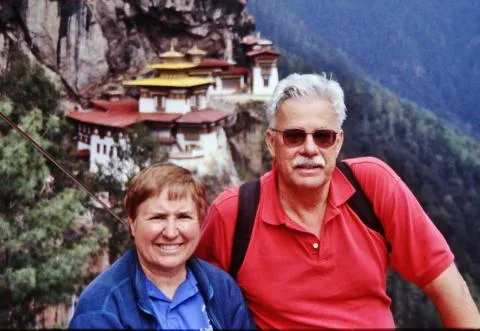Bhutan and Cambodia

The adventure started with a landing in Kolkata (Calcutta) due to mechanical difficulties, unexpectedly adding a fourth country to the itinerary. The trip ended with a short stay in Bangkok.
The Seekins based their Cambodia activities in the tourist city Siem Reap, renting bicycles to visit the nearby temples despite the intense heat and wilting humidity. The temples, including Angkor Wat, Angkor Thom, East Baray, and several others, are the crumbling remains of the great capital city of the Kmer Empire of the ninth through sixteenth centuries. The next days they sensibly hired a tuk-tuk and driver to tour the more remote temples and visit one of the floating villages on Tonle Sap, Southeast Asia’s largest freshwater lake.
The heart of the tour was Bhutan, the only remaining Himalayan Buddhist kingdom, where the Seekins joined a group organized by a friend. Their Bhutanese guide was a university-educated biologist who had worked at the International Crane Foundation in Wisconsin. Bhutan has one of the world’s 15 species of cranes. Like many crane species, it’s endangered from habitat loss. Bhutan’s forests contain 40 species of rhododendrons. Except for two or three, the Seekins saw them all in bloom. Birdwatching was a frequent activity.
Bhutan is a study in contrasts. The state religion is a branch of Tibetan Buddhism which is not under the Dali Lama. The country is rural and one of the least densely populated in Asia. Imposing Dzongs dominate the landscape. They’re combination administrative centers and monasteries dating from the time Bhutan was a theocracy and fragmented into fiefdoms. The present royal family united the country by force in the nineteenth century. The tour visited several dzongs in the drive across Bhutan.
To preserve Bhutanese culture, television and the internet were banned until 1999. National costume, gho for men and kira for women, is compulsory for schoolchildren and adults in public. The government runs tourism and the number of visitors is strictly limited. Tourists pay a flat fee per day regardless of the size of the group, their itinerary, or the comfort of their accommodations. The fee includes the compulsory guide and all meals and lodging.
In 2005, the king ushered in a constitutional monarchy, resulting in national parliamentary elections for the first time in 2007. Drivable roads are very limited. Health care is good but often far away. The government’s goal is to increase “gross national happiness.” It’s a nation of less than 800,000, yet the 1990s saw a forced removal of possibly 100,000 Bhutanese of Hindu Nepali ethnicity.
The highlight of the Seekins tour was the Paro Tschechu, a four-day religious festival featuring ritual dances by monks in costumes representing demigods and daemons. Toward the end, a gigantic thangkha, a textile painting of the Buddha, is revealed, said to bring instant enlightenment to all who view it. Michael Palin of Monty Python fame was in the audience with a crew filming for his documentary on travels in the Himalayas and the Seekins meet him.
